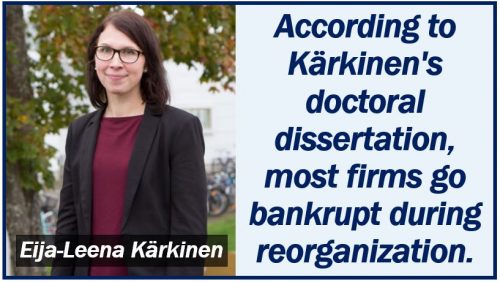Most companies go bankrupt during reorganization, Eija-Leena Kärkinen wrote in her doctoral dissertation. Kärkinen is studying at the University of Vaasa, a multidisciplinary, business-oriented university in Vaasa, Finland.
Companies reorganize because they want to turn around the business. However, by using current methods of reorganization, many businesses do not become viable, says Kärkinen.
Some companies go bankrupt before confirming a reorganization plan. Others, on the other hand, go bust while implementing their plan.
Bankruptcy occurs when a person, company, government, or any entity cannot pay back debts. Bankruptcy is a legal status which a court order initiates. The word ‘bust‘ is an informal term for ‘bankrupt.’
Reorganization – types of firms that go bust
Kärkinen found that there is not just one type of firm that goes bankrupt during the reorganization process.
The financial situations of companies that failed before undergoing the plan were quite different, Kärkinen found. Those that failed during the implementation of the plan were also quite different.

Kärkinen said:
“Previous belief was that only certain types of firms fail in reorganization, but according to my results, the firms that fail differ from each other.”
Many plans are too superficial
According to Kärkinen, some plans focus too much on companies’ financial situation. Many do not consider the reasons behind the companies’ problems.
Kärkinen explained:
“Many times the financial figures are only analyzed, but the reasons behind the financial distress may not be examined. Therefore, the actions used to turn around a firm may not be right.”
She believes that companies and the administrators who prepare the plans need to have enough time and information. Specifically, time and information to determine why the company had financial problems in the first place. Only then, can they prepare a proper and efficient plan.
Reorganizing small companies
Kärkinen’s dissertation included many types of firms. Most of them were small or very small companies.
The bankruptcy of a small business can be a difficult situation for the entrepreneur, creditors, and other stakeholders.
When a reorganization is successful, everybody wins – the firms, stakeholders, and the whole economy.
After a successful reorganization, the company can continue doing business and its workers still have their jobs.
Citation
Kärkinen, Eija-Leena (2018). “Essays on Efficiency of Reorganization Process – a Life Cycle Approach.” Acta Wasaensia 410. Väitöskirja. Vaasan yliopisto. University of Vaasa. http://urn.fi/URN:ISBN:978-952-476-831-3.
